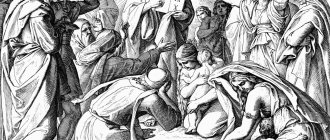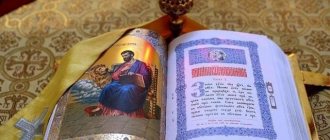What is the Bible
The Bible is a collection of writings compiled by different authors. The Holy Scriptures are written in different literary styles, and interpretation comes from these styles. The purpose of the Bible is to bring the words of the Lord to people.
The main topics are:
- creation of the world and man;
- the fall and expulsion of people from paradise;
- life and faith of the ancient Jewish peoples;
- the coming of the Messiah to earth;
- life and suffering of the Son of God Jesus Christ.
Title and Contents of the Bible
Before we begin to present the biblical story, let us give brief information about the Holy Bible.
“Bible” (biblia) is a Greek word, translated into Russian by the word “books”. It was named so in the fourth century by St. John Chrysostom and St. Epiphanius of Cyprus because it contains many sacred books. The Holy Bible is a collection of books written by the inspiration and revelation of the Holy Spirit through God's chosen people called prophets and apostles . Since the books of the Holy Bible were written by people under the inspiration of God, these books are called inspired and sacred, for everything that comes from God is spiritual and holy. This is why the Bible is often called Holy Scripture. The Bible is divided into two sections - the Old Testament and the New Testament. When applied to Scripture, "covenant" means the union of God with men. The Old Testament or the union of God with people was concluded during the time of Adam and continued until the coming into the world of Christ the Savior - the Son of God. With the coming of the Savior, a New Covenant was established between God and people, which continues to this day.
There are seventy-seven sacred books in the Bible. Of these, 50 books are of the Old Testament and 27 of the New Testament. The Old Testament books are divided into canonical, that is, inspired by God, there are 39 of them, and non-canonical, that is, not inspired, but having an edifying character, there are 11 of them.
With all the diversity of the contents of the Holy Bible, a wonderful unity is noticeable in it. A holy and great idea runs through all the books as a red thread - the education and salvation of fallen man.
The Holy Bible was compiled over fourteen centuries. Her books were written in the Arabian desert, and in Palestine, and in Babylon, in Greece and Rome, by persons of various education and social status. But no matter whose hand inscribed the sacred writings during this long period of time - whether the hand of the historian, legislator or poet, Moses, taught in all the wisdom of the Egyptians, or his successor Joshua, the learned Saint Apostle Paul or the fisherman Saint Apostle John - they all speak of the same one God, merciful and just. All the writers of the Holy Bible speak of the same fallen man, sinful and weak. They all talk about the same angels and saints who take a living and active part in human life, and about the same bliss of eternal life. If we were to bind some other works into one volume, for example, the best works on medicine that have appeared over the course of 1400 years, and then treat a patient using this book, then no one would benefit from such treatment. The same must be said about other works, for example on philosophy. Another thing is the Bible, it represents a vivid example of organic unity in diversity; all the details in the contents of the Bible serve to reveal one story, the history of the Kingdom of God, starting from the creation of heaven and earth and ending with their renewal, the creation of a new heaven and a new earth. One thought, one spirit penetrates the Bible and transforms it into a harmonious whole. Even the differences between the Old and New Testaments, which sometimes apparently reach the point of contradiction, turn out, upon closer examination, to be different stages of a single process of salvation of the human race.
Everything in the Holy Bible is edifying, although not everything is immediately understandable. For example, the wondrous faith of Abraham, who, at the word of the Lord, left his homeland to go to an unknown land, and was then ready to sacrifice his only son, is edifying. he was convinced “that God is able to raise from the dead” (Heb. 11:19).
But not everything in the Bible is offered for imitation. She also gives us terrifying examples of error and fall, from which we can study the psychology of sin in order to hate it with all our being and not allow it in our lives.
All the canonical books of the Old Testament were originally written in Hebrew, and the books of the New Testament were originally written in Greek, with the exception of the Gospel of Matthew, which was written in Hebrew.
In the 3rd century BC. The Old Testament books were translated into Greek. This work was done by 72 interpreters, so this translation is abbreviated as the translation of the seventy
.
In the 4th century AD. Blessed Jerome translated the Bible from Hebrew into vernacular Latin. Therefore, it began to bear the name Vulgate
, which means widespread, accessible. This translation is used by the Catholic Church to this day.
The Holy Bible was translated into Slavic in the second half of the 9th century through the works of the holy brothers Cyril and Methodius. The holy brothers translated the Bible into Slavic from the Greek translation of the seventy. The Bible was translated into Russian both from Hebrew - the Old Testament, and from Greek - the New Testament. The translation was completed in 1876, and since it was made with the blessing of the Holy Synod, it began to be called the Synodal translation.
According to their content, the books of the Old Testament are divided into four categories: legal, historical, teaching and prophetic. This, of course, does not mean that some books in the Bible contain only history, others only laws; others are prophecies, etc., but this means that some books are primarily lawful, others are primarily teaching, etc.
The Old Testament story begins with God's creation of the world and man and ends with the coming of Christ the Savior into the world. According to church tradition, 5508 years passed from the appearance of the first man to the Nativity of Christ, but this figure is approximate and does not have a dogmatic character.
If the Holy Bible is the Sacred Word of the Most Holy God, then it must be read with deep faith and reverence. Faith is inner spiritual vision, which can see what our bodily eye is unable to see. If we open the holy pages of the Bible without a living, fiery faith in God, then we will perceive it simply as a literary work of the human mind, filled with various implausible legends in which there are only contradictions. An unbeliever who has lost spiritual sight will not see and will not perceive with his unbelieving spirit its spiritual saving truths in the Bible; he will not see God in it. And a deeply religious person, when he reads the Holy Bible, talks with God, since the Bible is the words of God, through which God speaks to people.
3. About various forms and methods of expression
meaning of scripture
The meaning of Holy Scripture, that is, those thoughts that sacred writers, inspired by the Holy Spirit, expressed in writing, is expressed in two ways: directly - through words, indirectly - through persons, things, events and actions described by words. Therefore, there are two main types of meaning of Holy Scripture:
a) in the first case – verbal or literal meaning;
b) in the second - the meaning is objective or mysterious, spiritual.
Sacred writers, expressing their thoughts through words, sometimes use them in their own, literal meaning, and sometimes not in their own, figurative meaning. So, for example, the word “hand”, according to generally accepted usage, means a certain member of the human body. But when the psalmist David prays to the Lord: “Stretch out Your hand from on high” (Ps. 143:7)
, then it is obvious that here the word “hand” is used in the sense of general help and protection from the Lord, thus, the original meaning of the word is transferred to a spiritual, higher, mental object.
In accordance with this use of words, the literal meaning of Holy Scripture is divided into two types:
1) proper or literal meaning;
2) the meaning is improper or literally figurative.
So, for example, in the book of Genesis (chapter 1, vv. 8-10)
the word “water” is used in its own, literal sense: “And God said, Let the waters be gathered together... and he called the gathering of the waters seas,” and in Psalm 68
(v. 2)
: “Save me, O God, for the waters have reached my soul )” – figuratively, in the sense of sorrows and disasters.
Further, in the book of Numbers (chapter 6, v. 3)
, the name wine means an intoxicating drink made from grapes;
and in the mouth of Christ the Savior (Mark 2:22)
“new wine” means New Testament teaching. In general, Holy Scripture uses words in a figurative sense when speaking about spiritual objects, imaginable in the mind, for example, about God, about his properties, actions, and the like.
When thoughts in Holy Scripture are expressed not through words directly, but through persons, things, actions and events described by words, then a mysterious meaning appears.
But since in this case the sacred writers take persons, things, actions and events from different areas, place them in unequal relationships with each other and with the concepts expressed, therefore the forms of expression of the mysterious, the meaning of the Holy Scriptures can be divided into the following types: prototype, parable, apologist, vision and symbol.
A. By prototype
This is a way of expressing the mysterious meaning of Holy Scripture when sacred writers communicate the concept of some higher spiritual objects through actual church-historical persons, things, actions and events.
Old Testament writers, narrating about various events of the Old Testament Church, very often mean by them and reveal through them the future events of the New Testament Church. In this case, the prototype is a pre-image contained in the persons, events, things and actions of the Old Testament of what belongs to the New Testament, which was later fulfilled in Christ the Savior and the Church founded by Him.
So, for example, Melchizedek, king of Salem and priest of the Most High God (Gen. 14, 18-20)
, went out to meet Abraham, who was returning after the victory over the allied kings, brought him bread and wine and blessed Abraham. For his part, Abraham donated a tenth of the spoils to Melchizedek.
Everything that the Holy Scripture tells about in this case is a real church-historical fact. But, in addition to its modern historical significance for patriarchal times, the above narrative from the 14th chapter of the book of Genesis also has a deep, mysteriously educational significance in relation to New Testament times. The historical person of Melchizedek, according to the explanation of the Apostle Paul (Heb. 7, 1-2)
, was a prototype of Jesus Christ. The objects brought out by Melchizedek - bread and wine, according to the explanation of the Church Fathers, pointed to the New Testament sacrament of the Eucharist.
Historical event - the passage of the Israelites through the Red Sea (Ex. 14, 16-30),
in addition to its modern historical significance, according to the Apostle Paul
(1 Cor. 10: 1-2)
, it prefigured New Testament baptism, and the sea itself contained, according to the explanation of the Church, the image of the Unartificed Bride - the Virgin Mary.
According to the Apostle Paul (Heb. 10:1)
, the entire Old Testament was a prototype of the New Testament or, as the Apostle says, a shadow of the coming New Testament blessings.
B.
When sacred writers, in order to clarify certain thoughts, use for this purpose persons and events, although not historical, but quite possible, usually borrowed from everyday reality, then such a literary form of expressing the mysterious meaning of Holy Scripture is called a
parable.
Thus, a parable is an allegory. In the Middle East, even in ancient times, people loved to express their thoughts in the form of a parable. Therefore, it is no coincidence that our Lord Jesus Christ often presented his teachings in parables. This way of presenting spiritual truths was accessible to the common people.
IN.
When, in order to express some thought, sacred writers attribute human properties and actions to animals and even inanimate objects, so that they speak and act like people, then this form of expressing the mysterious meaning of Holy Scripture is called an
apologist.
Among the Old Testament apologists, one can point to the apology contained in the book of Judges (chap. 9, 8-16)
. Here the sacred author attributes human properties to trees, so that trees can think and speak like people. He does all this in order to reveal the deep moral truth of Holy Scripture.
G.
When the thoughts of the Holy Scripture are revealed through special images and pictures that the Lord showed to chosen people, who are usually in a special, mystical state, in a dream or in reality, then this method of revealing the meaning of the Holy Scripture is called
vision.
So, for example, Jacob sees in a dream a mysterious staircase connecting heaven with earth, along which a host of angels ascends and descends, at the top of which stands the Lord Himself (Genesis 28: 11-17)
. Jacob's Ladder was a prototype of the Mother of God. The vision itself shows that the Lord always provides for people through His angels, and when the times were fulfilled, He Himself descended to people, incarnate through the Holy Virgin Mary.
Prophet Ezekiel (Ezekiel 37:1-14)
sees a field strewn with dry human bones. These bones, obeying the word of the Lord, are secluded together, clothed with flesh and skin, a life-giving spirit is given to them, and they become living people. According to the explanation of God Himself, this vision meant the political restoration of the Israeli people, who had languished in Babylonian captivity and had lost hope of returning to their former political independence. According to the interpretation of the holy fathers, this vision also pointed to the coming general resurrection of the dead.
D.
When the thoughts of the Holy Scripture are revealed through special external actions that, at the command of the Lord, were performed by His chosen ones, then this way of expressing the mysterious meaning of the Holy Scripture is called
a symbol.
Thus, the prophet Isaiah, at the command of the Lord, walks naked and barefoot for three years as a sign of future disasters for the Egyptians and Ethiopians, when the king of Assyria takes them into captivity naked and barefoot (Isa. ch. 20)
.
Prophet Jeremiah, in the presence of the elders, breaks a new earthen vessel as a sign of the destruction of Jerusalem by the Chaldeans (Jeremiah ch. 19)
.
What language is the Bible written in?
The first chapters were written in the language of the ancient Jews - Hebrew. The texts compiled during the life of Jesus Christ were written in Aramaic.
For the next few centuries, the Word of God was written in Greek. Seventy interpreters were involved in the translation into Greek from Aramaic. Servants of the Orthodox Church use texts translated by interpreters.
The first Slavic Holy Scripture was translated from Greek and is the first book to appear in Rus'. The translation of the sacred meetings was entrusted to the brothers Cyril and Methodius.
During the reign of Alexander I, biblical texts were translated from Slavic into Russian. Then the Synodal translation appeared, which is also popular in the modern Russian Church.
Septuagint and Tanakh
The Orthodox (patristic) heritage is based on the Septuagint - the translation of the 70 sages (interpreters). We are talking about the Holy Scriptures, formed and translated from Hebrew into Ancient Greek for the Jews of Alexandria, who lived before the birth of Christ.
The Septuagint differs significantly from the position of later Jewish (Masoretic) scribes, who, from the 7th to the 11th centuries after Christ, were engaged in organizing the Tanakh, a list of 24 Jewish books. Those. they corrected and, in fact, canonized, created their list after the final break between Judaism and Christianity!
The Greek version (unlike the Hebrew) has additional sections. Thus, in the book of Esther there is an addition to the 10th chapter, and in the book of Daniel there are additional chapters 13 and 14. In addition, the Greek version also traditionally includes lists that are not generally recognized by Jewish rabbis: two books of Ezra (second and third), Tobit, Judith, the Wisdom of Jesus, son of Sirach, the Wisdom of Solomon, the book of the prophet Baruch, the Epistle of Jeremiah, as well as three books of Maccabees.
The ancient Jewish Tanakh contains only 22 books (39 books in the Christian Bible), and the Orthodox Old Testament - 50. This is due to the fact that 11 biblical books written in Greek in the 4th-1st centuries. before the Nativity of Christ, the Jewish rabbis do not recognize.
“The main problem lies not so much in the different versions of the Old Testament text, but in the attempt of heterodox to distort the history of the formation of the Holy Scriptures”
Thus, in the Orthodox Bible there are 77 books (of which 50 are Old Testament), and in the Protestant Bible - 66. However, the main problem lies not so much in the different versions of the Old Testament text, but in the attempt of heterodox to distort the history of the formation of the Holy Scripture, using their heretical views, in fundamentally inconsistent with patristic teaching (and sometimes even common sense).
Why is this the Holy Book of Christians
The Bible is not just a holy book. This is a handwritten source of human spirituality. From the pages of Scripture people draw wisdom sent by God. The Word of God is a guide for Christians in their worldly life.
Through Biblical texts the Lord communicates with people. Helps you find answers to the most difficult questions. The books of the Holy Scriptures reveal the meaning of existence, the secrets of the origin of the world and the definition of man's place in this world.
By reading the Word of God, a person comes to know himself and his actions. Becomes closer to God.
Devil's temptation
When the devil tried to tempt Christ in the desert, he used the Holy Scriptures for greater “persuasion”: he suggested that the Son of God throw himself from the wing of the temple, perversely quoting a passage from Psalm 90 (Matthew 4:6).
The earthly followers of the “father of lies” also engage in similar satanic techniques: in words they call themselves Christians, but in reality they try to “drive” the Bible into the framework of their (invented) movements, heresies and sects. Each of them has their own faith and their own misconceptions.
Many of us are familiar with typical cases from life: on the street (or in the subway), a smiling stranger approaches passers-by and kindly offers to “get acquainted” with God. In doing so, he usually quotes biblical passages.
Unfortunately, many believers (including Orthodox Christians) do not always understand that the newly minted “catcher of souls” is trying to impose not only his interpretation, but also “his” Holy Scripture: Protestants thoughtlessly (thoughtlessly?) “threw out” the text of the Old Testament. » non-canonical books, mistakenly considering them “apocryphal” (i.e. secret, and therefore doubtful). Although, as you know, the apocrypha have never been part of the Holy Scriptures.
One evidence of such a crafty approach is the activity of the so-called “Trinitarian Bible Society” (which actively supplies us with “their” bibles): in “its” Old Testament list there are only 39 books, i.e. 11 less than the Orthodox.
What is the reason? Strangely enough, in this matter, many trust more not the Church of Christ, but... those who reject Him as God! Yes, yes, Baptists, Pentecostals, charismatics, Adventists (and other biblical “experts”) rely on Judaism, i.e. into 24 Jewish books, which were subsequently “divided” into the aforementioned 39 Old Testament books. As a result, we have what we have: two Bibles - two paths...
Gospel and Bible - what's the difference
The Holy Scriptures are a collection of books divided into the Old and New Testaments. The Old Testament describes the time from the creation of the world until the coming of Jesus Christ.
The Gospel is the part that makes up the Bible texts. Included in the New Testament portion of Scripture. In the Gospel, the description begins from the birth of the Savior to the Revelation, which he gave to His Apostles.
The Gospel consists of several works written by different authors and tells the story of the life of Jesus Christ and His deeds.
Recognition of Talmudists
The Alexandrian Jews (who used the Greek version of Scripture) did not believe that prophecy in Israel dried up after Ezra. The very existence of the Septuagint shows that the processes of Jewish “canonization,” or rather the reduction in the number of sacred books, in Palestine began much later than the time when the biblical texts were translated into Greek.
Thus, Jews used more books during the Second Temple period than they did after its destruction in later rabbinic Judaism. Orthodox theologian Alexey Somov, the author of the report “The Canon of the Books of the Old Testament: History, Problems and Prospects for Research” (St. Philaret Orthodox Christian Institute), also drew attention to this point.
According to his research, “a clear indication of a canon of 24 books, divided into three sections, as well as a list of these books, appears in the baraita (teaching) to the Babylonian Talmud treatise Bava Batra 14b-15a at the end of the 2nd century. n. e." Please note: we are talking about the second century AD - a period when Judaism and Christianity were already going down different paths.
It should also be noted that the Babylonian Talmud mentioned was compiled in the 6th century AD. (a century later than the Jerusalem Talmud). Therefore, it is not clear on what basis gentlemen Protestants claim unfoundedly that the supposedly Jewish “canon” was known even during the earthly life of Jesus Christ. Are they really not afraid to sin against New Testament history?
Of course, Christ used such expressions as “scriptures,” “law,” and “prophets.” But! Which books exactly did He mean? The New Testament does not talk about this. Also, the Apostle Paul does not name specific books when he says that “all Scripture is inspired by God.” And in the conciliar letter of the Apostle Jude we even see references to the apocrypha (about the prophecy of Enoch, the disputes between Satan and the Archangel Michael about the body of Moses). If the Old Testament canon had already been formed at that time, would Christ’s disciples have kept silent about it?
The absence of the “canon of Ezra” is evidenced by early Christian writers, and decisions of Ecumenical Councils, and ancient scrolls at Qumran (where not only biblical texts were found, but also a huge amount of other religious literature).
What parts does the Bible consist of?
Biblical texts are divided into canonical and non-canonical parts. Non-canonical ones include those that appeared after the creation of the New Testament.
The structure of the canonical part of Scripture includes:
- legislative: Genesis, Exodus, Deuteronomy, Numbers and Leviticus;
- historical content: those that describe the events of holy history;
- poetic content: Psalms, Proverbs, Song of Songs, Ecclesiastes, Job;
- prophetic: writings of great and minor prophets.
Non-canonical texts are also divided into prophetic, historical, poetic and legislative.
Where did the “canon of Ezra” come from?
The word “canon” itself is not Hebrew, but Greek: it means a set of norms and rules. However, despite this, Protestants came up with a myth about the so-called “Canon of Ezra”: according to their version, the Jews seemed to have fully formed their canon allegedly back in the time of the high priest Ezra (V-VI centuries BC), when they were returning from Babylonian captivity and reproduced their statehood on the basis of Torah law. And of course, such an unfounded thought raises more questions than answers.
Firstly, Ezra lived much earlier than the lists of Old Testament (canonical) books mentioned in church history were recorded. In addition, the Orthodox have the Septuagint, which appeared much later. Therefore, if you believe in the “Canon of Ezra” (supposedly consisting of only 24 Jewish books), then it is not clear: why did the Jews themselves, who lived in Alexandria, add other Hebrew texts to this “canon”, which they used in translations into Greek?
Secondly, it was the Septuagint, quotes from which are found in the New Testament, that played an important role in church history: it became a kind of biblical canon: it was it that was used for translations into other languages (for example, into Church Slavonic).
Orthodox Bible in Russian - text of the Old and New Testaments
Reading Biblical texts begins with the desire to know God's Word. The clergy advise the laity to begin reading from the pages of the New Testament. After reading the New Testament books, a person will be able to understand the essence of the events described in the Old Testament.
The full text of the Bible can be read here.
To understand the meaning of what is written, you need to have at hand works that provide a decoding of the Holy Scriptures. An experienced priest or confessor can answer any questions you may have.
The Word of God can provide answers to many questions. Studying Bible texts is an important part of the life of every Christian. Through them, people come to know the grace of the Lord, become better people and move spiritually closer to God.









